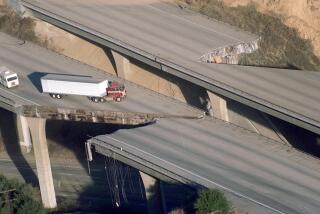NASA uses radar to find human heartbeats in collapsed buildings
NASA engineers have built a device that uses radar to detect heartbeats in the rubble of collapsed buildings, with technology typically used to explore other planets. The FINDER device, developed with the Department of Homeland Security, could help search-and-rescue teams find survivors trapped underneath the wreckage – even when those victims can’t call for help.
Identifying people who are still alive in a collapsed building is a major challenge for urban rescue missions, said Jim Lux, task manager at Jet Propulsion Laboratory for FINDER (short for Finding Individuals for Disaster and Emergency Response). Trapped victims often can’t be heard, and using microphones to pick up their voices depends on their ability to call for help.
“The other search technique relies on the victims making noise,” Lux said. The JPL device “can find an unconscious and unresponsive victim.”
This new technology uses radar, the same technique employed by missile guidance systems and air traffic control. FINDER sends out a low-powered microwave signal – a fraction of what cellphones use – toward the rubble. Some of the microwave light bounces off of the rubble, but some of it manages to penetrate the debris and bounce off of trapped victims.
Unlike the rubble, the victim is actually moving rhythmically. The chest rises and falls as the victim breathes, and moves from heart beats – and the head moves as the veins on the scalp fill and empty out, Lux said. So that nearly imperceptible movement creates slight differences in timing when the waves bounce back, which the device can pick up.
“We looked for really tiny motions,” Lux said.
The researchers can distinguish people from animals, Lux said, because humans have a fairly unique range of heartbeats and respiration rates, and experts can use them in combination to identify human victims.
As for how they differentiate a signal potentially filled with heartbeats and breathing from other random movements (like a tree rustling), researchers use a technique called signal processing – something engineers at JPL are well-versed in, Lux said. It is basically the same technique radio astronomers use to identify individual pulsars from all the background noise, or to decipher a faint wobble in the signal from a spacecraft around Jupiter or Saturn.
At a training site in Lorton, Va., JPL engineers on Wednesday gave members of the urban search-and-rescue team Virginia Task Force 1 the device to test out in the rubble of a collapsed building. Volunteer victims had earlier crawled into the wreckage through strategically placed concrete pipes and waited to see if they were discovered. FINDER picked up all four volunteer victims in the first round, and got full marks in the second round as well, Lux said.
The test also provided other feedback. Searching a house-sized building (about 30 by 30 feet) would take about 10 minutes, Lux said, while it took roughly half an hour to find the volunteer victims in a much larger structure (approximately 100 feet by 250 feet, Lux estimated). The rescuers wanted the device to work faster, and Lux said researchers could likely cut the time in half.
“That’s why it’s important to talk to search-and-rescue folks,” Lux said. “They have a wealth of knowledge about the things that work in the field that we just don’t have.”
ALSO:
A hunt for dark matter in a former gold mine
Eureka! Did crashing neutron stars forge all gold in Universe?
50 shades of window? ‘Smart glass’ blocks heat, light at flip of switch
Ancient Egyptians forged jewelry beads with meteorites from space







